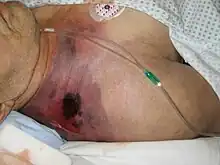Gas gangrene
Gas gangrene is a serious but rare form of bacterial infection that occurs when a pressure ulcer becomes infected with the clostridium bacteria[1]. It is a form of necrotizing myositis.
| Gas gangrene | |
|---|---|
| Other names | Myonecrosis |
 | |
| Person with gas gangrene. The patient had gone into shock. | |
| Medical specialty | Infectious disease |

The bacteria thrive in environments where there is little or no oxygen (anaerobic). They produce gases and release dangerous toxin[1], over tissues where there is gangrene. Symptoms of gas gangrene include severe pain and rapid swelling of the skin. Gas gangrene requires immediate treatment (it is a medical emergency). In the most serious of cases, it may be necessary perform surgery to amputate (debridement) on the affected body part to prevent the gangrene from spreading to the rest of the body.[1]. It can cause sepsis.
Symptoms
There is quick onset of:[2]
- myonecrosis
- the supply of blood is cut off from the skeletal muscle and it dies (skeletal muscle infarct)
- muscle swelling
- gas production
- sepsis
- severe pain[1]
Treatment[2]
- remove all dead tissue (eg amputation) (debridement)
Benzylpenicillin with or without clindamycin.
Hyperbaric oxygen can improve survival and lower the number of debridements.
Related pages
References
- "Pressure ulcers". nhs.scot. February 2023.
- Oxford Clinical Handbook of Medicine. Oxford University Press. 2017. p. 660. ISBN 978-0-19-968990-3.